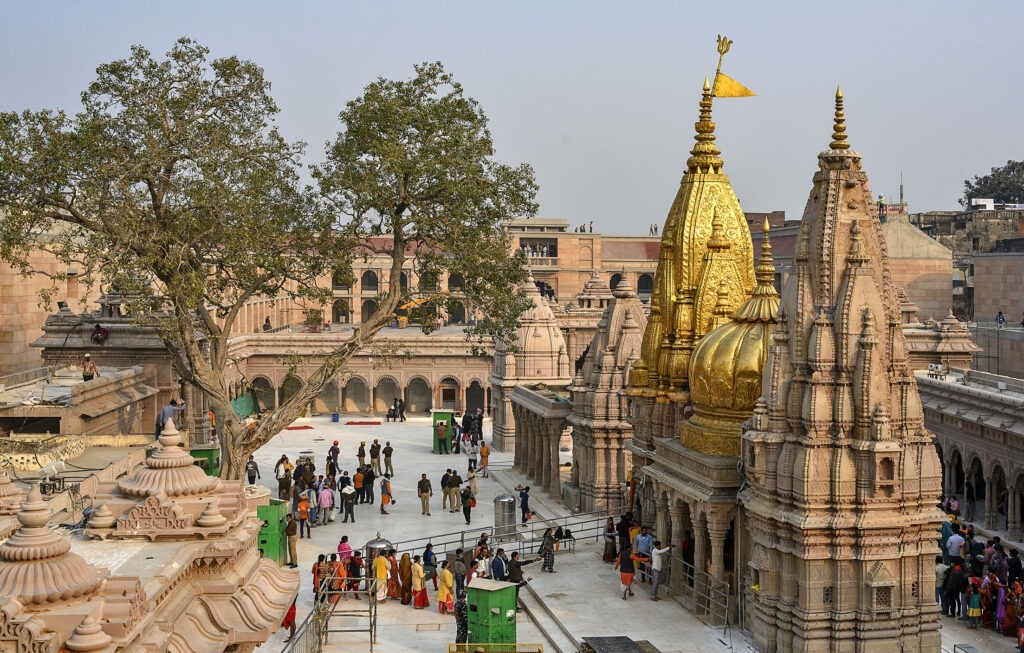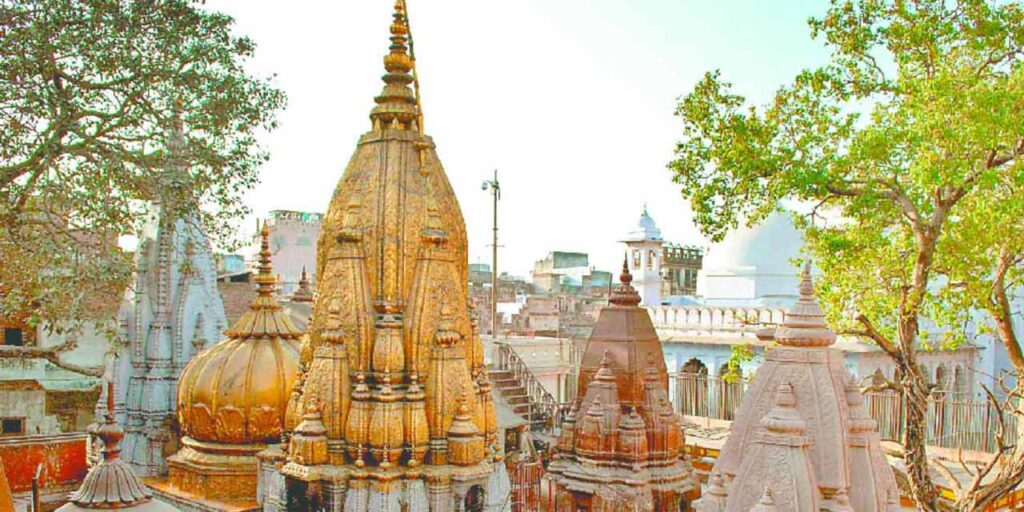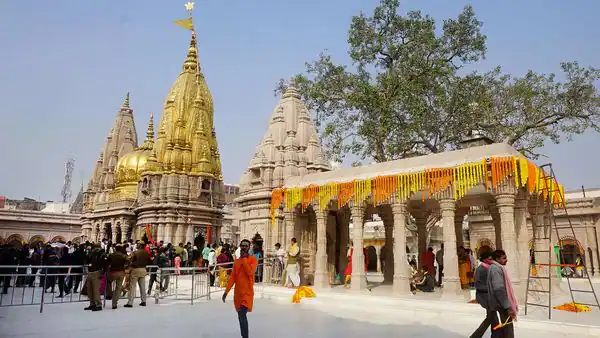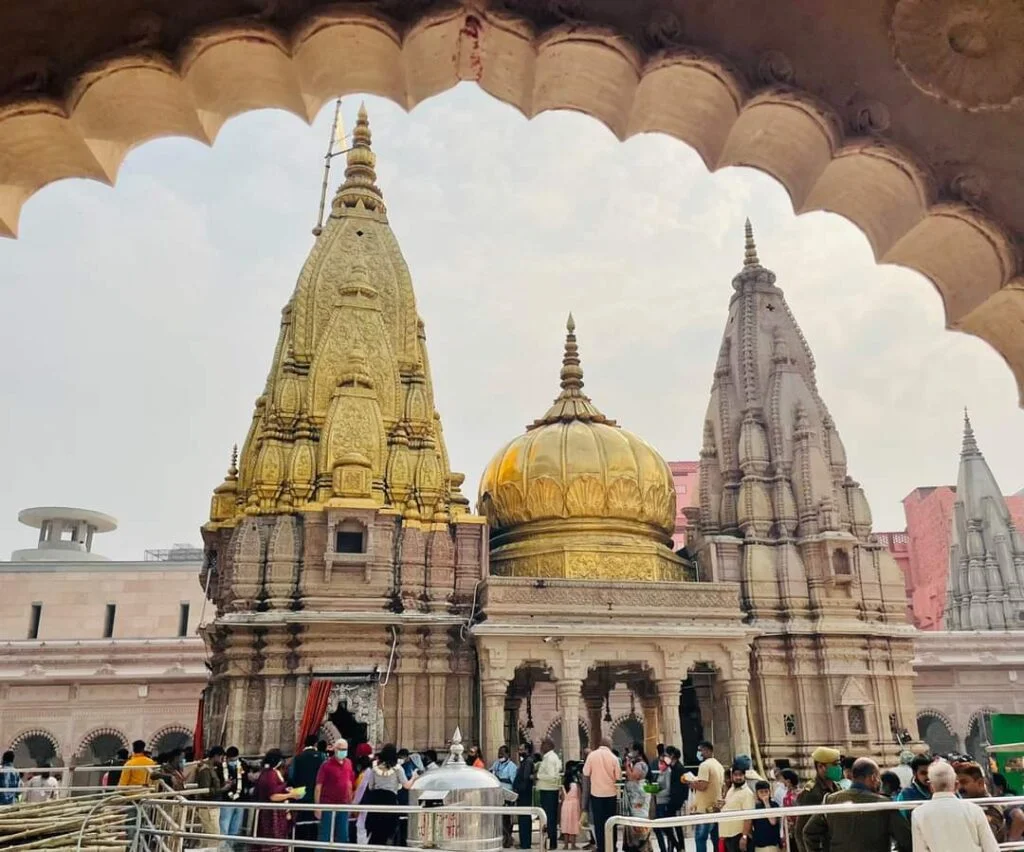
Kashi Vishwanath Temple, Varanasi
The Kashi Vishwanath Temple in Varanasi is a revered Hindu shrine dedicated to Lord Shiva and one of the sacred 12 Jyotirlingas, drawing devotees from around the world. Surrounding the temple, Varanasi’s spiritual essence comes alive through its iconic ghats—Assi Ghat, known for its peaceful ambience and morning rituals; Harishchandra Ghat, one of the oldest cremation ghats symbolizing the cycle of life and liberation; Dashashwamedh Ghat, famous for its vibrant Ganga Aarti; and Manikarnika Ghat, the most sacred cremation site associated with moksha. Adding to the city’s historical depth is the Ramnagar Fort, an 18th-century structure showcasing royal architecture and cultural treasures. Nearby, the Kal Bhairav Temple, dedicated to the fierce guardian form of Lord Shiva, holds immense religious significance for devotees. Together, these sacred landmarks highlight the spiritual, cultural, and historical richness that defines Varanasi and enhances the divine aura of the Kashi Vishwanath Temple.
Namaste 🙏 नमस्ते
Secure your visit • अपनी यात्रा सुरक्षित करें
Historical background and Architectural splendor
Guru Nanak, the first Sikh guru, is said to meditate at the holy site where Harmandir Sahib was built. The sacred tank Amrit Sarovar was founded in 1577 by Guru Ram Das, the fourth Sikh guru. And the construction of the gurudwara was initiated by the fifth Sikh guru – Guru Arjan.
Guru Arjan designed it to be built in the centre of the tank. The construction started in 1581 and took almost eight years to complete. Then, he installed the Adi Granth, the holy scripture of Sikhism, inside the temple. The Akal Takht in the complex was constituted by the sixth guru, Guru Hargobind.
Guru Arjan was arrested by the Mughals after the construction. And Harmandir Sahib Amritsar fell into the hands of the enemy. Guru Gobind Singh liberated it later, in the 18th century. He was the tenth Sikh guru.After Guru Gobind Singh’s death, Harmandir Sahib had been under attack by Islamic rulers. It was in 1762 when this religious heritage was blown away. Maharaja Ranjit Singh rebuilt it in 1809 and adorned it with gold foil. Thus, Harmandir Sahib came to be called the Golden Temple.It was again destroyed in 1984 when the government wanted to capture militant Sikhs hidden inside. Later, from 1995 until 1999, it was rebuilt
While the Golden Temple dome is made from pure gold, the inner walls and door panels also exhibit goldwork. Copper sheets have been engraved with delicate designs and then covered with gold leaves. Even the ceiling is adorned with precious stones and gold.
The first floor of the Golden Temple is set up at a lower level below the ground. It’s decorated with rare paintings and marble sculptures. The stairs to the shrine go downwards, signifying humble living.
It’s a blend of Indian and Mughal architectural styles. You’ll find symbolisms of life everywhere in Harmandir Sahib in Amritsar. They’re in paintings, in the form of birds, animals and flowers.

Religious Significance
The Kashi Vishwanath Temple stands as a sacred haven in the heart of Varanasi, holding profound religious significance for Hindus. Devoted to Lord Shiva, the temple houses the revered Jyotirlinga, a divine symbol of cosmic light. Pilgrims believe that a visit to the temple, witnessing the sacred darshan of the Jyotirlinga, is a transformative experience, purifying the soul and bestowing spiritual liberation. It serves as a pivotal destination in the spiritual odyssey of devout Hindus, symbolizing the eternal presence of Lord Shiva. The Gyanvapi Well, nestled within the temple complex, is believed to cradle the sacred waters of the Ganges, further elevating the sanctity of the site. The religious rituals conducted at Kashi Vishwanath are deeply rooted in Hindu traditions, making it a shining beacon of faith, devotion, and spiritual enlightenment. For millions of worshippers, this temple stands as a revered abode of Lord Shiva, a place where blessings and divine grace are sought on the path of spiritual fulfillment.


Festival and Celebrations
Kashi Vishwanath Temple is a vibrant center of festive celebrations, adding fervor to the spiritual atmosphere of Varanasi. Key festivals and celebrations at the temple are Mahashivaratri, Kartik Purnima, Nag Nathaiya, Annakut Utsav and Kartik Snan.
Surroundings area & attractions
- Sankat Mochan Hanuman Temple: A revered temple dedicated to Lord Hanuman, located near the Assi Ghat.
Key Historical Events & Incidents:
- 1194: The original temple destroyed by Muhammad of Ghor.
- Mid-13th Century: Rebuilt by a Gujarati merchant.
- 16th Century: Demolished again, then rebuilt by Raja Man Singh and Raja Todar Mal.
- 1669: Emperor Aurangzeb destroys the temple and builds the Gyanvapi Mosque on its location.
- 1780: The current temple structure built adjacent to the mosque by Maharani Ahilyabai Holkar.
- 1835: Maharaja Ranjit Singh adds gold plating to the temple's spires
Seasons
Winter: Magh/Makar sankranthi spiritual phase
Ongoing Issues & Developments:
-
Gyanvapi Dispute: A long-standing legal and religious dispute over the land, with petitions filed for the restoration of the Gyanvapi site to the temple.
2021 Kashi Vishwanath Corridor: A major project inaugurated by PM Narendra Modi, creating a grand pathway from the temple to the River Ganga, significantly improving the pilgrim experience.
Significance:
- A key Jyotirlinga, one of the holiest shrines dedicated to Lord Shiva. Celebrates major festivals like Maha Shivaratri, a night when Lord Shiva performed the Tandava.
Connections
- Kashi Vishwanath Corridor (Dham): A game-changer, this project created wide, clean pathways connecting the temple directly to Manikarnika Ghat, eliminating congested lanes and offering direct Ganga access.
- Urban Ropeway: India’s first urban ropeway provides quick, hassle-free transport for devotees from the city to the temple area.
- River Access: The Corridor ensures pilgrims can easily reach the sacred Ganges River and its ghats from the temple complex.
- Road & Public Transport: Varanasi has robust road networks, and auto-rickshaws, e-rickshaws, and taxis are readily available to reach the temple area.
- Rail Connectivity: Served by Varanasi Junction (Varanasi Cantt) and Varanasi City Railway Station, with Mughalsarai being a major nearby hub
- Air Connectivity: Lal Bahadur Shastri International Airport (VNS) in Varanasi connects the city to major Indian cities.
"Feel the heart of Kashi – from the sacred Kashi Vishwanath Temple to the mesmerizing Ganga Aarti, let Namandarshan guide your spiritual journey with peace and devotion."
FAQs
The temple is located in Varanasi (Kashi), Uttar Pradesh, on the western bank of the Ganga River, near Lalita Ghat.
Opening: 2:30 AM – 3:00 AM
Closing: 10:30 PM – 11:00 PM
Timings vary slightly during festivals and special occasions.
The Mangala Aarti (early morning) is the most sought-after.
Advance booking can be done through the temple’s official website or counters near the temple.
General Darshan: Free
Special Aartis / Rituals: Paid passes required.
Many devotees follow traditional clothing:
Men: Dhoti–Kurta
Women: Saree
For those not in traditional dress, darshan is still allowed but entry inside the sanctum may be restricted.
No. Phones, cameras, large bags, and electronic items must be kept in the cloakroom near the entrance.
Early morning (less crowd, peaceful darshan)
October–March (pleasant weather)
Festivals like Mahashivratri attract huge crowds.
Airport: Lal Bahadur Shastri Airport (approx. 20–25 km)
Railway Station: Varanasi Junction / Kashi Station (4–6 km)
Local transport: Auto, e-rickshaw, cycle rickshaw, or on foot through narrow lanes.
Ganga Dwar (Riverside Gate): For visitors coming by boat or from the ghats
Main Entrance (City-side): For those arriving by vehicle
It provides wide, clean, and easy access from the Ganga River to the temple, reducing crowding and improving flow for lakhs of visitors daily.
Kashi Vishwanath houses one of the 12 Jyotirlingas of Lord Shiva. It is believed that a visit here grants liberation (moksha).
Yes, the temple is open to all visitors who respect the temple’s traditions and security guidelines.
Yes. Paid passes for Priority Darshan or Aarti can be purchased online or at designated counters.
Yes. Many rituals including Rudrabhishek, Laghu Rudra, and other offerings are available via advance booking.
Yes, dry Prasad, Bilva leaves, and puja kits are available at designated counters.
Yes. The entire Kashi Vishwanath Dham has been declared a plastic-free zone. Plastic bags, bottles, and containers are not allowed.
Yes:
Wheelchairs
Priority queues
Escort support near entrance (based on availability)
Phones or cameras
Large bags
Metal items
Tobacco products
Food items
Plastic of any kind
Peak crowds occur during:
Sawan month
Mondays
Mahashivratri
Festivals and full moon days
Plan early morning visits to avoid long queues.
Yes. Many devotees prefer reaching via Dashashwamedh Ghat or Lalita Ghat and entering through the Ganga Dwar, which offers a scenic approach.
• Sarva Darshan – Free
• Sugam Darshan – ₹300 (Quick Entry)
• Sparsh Darshan – Touching Shivling (Varies)
Visitor information:
Address
